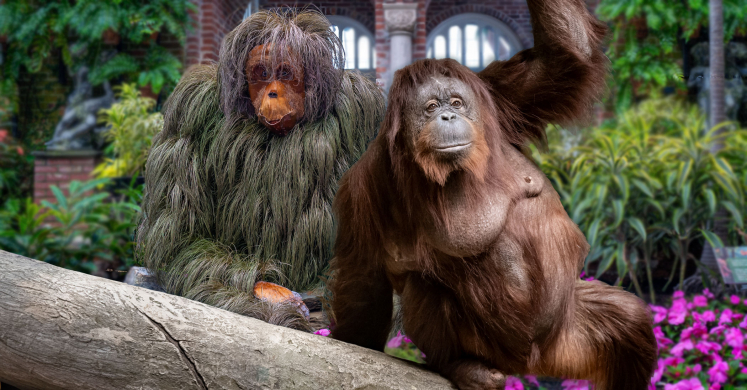Blog

Jungle Creatures and Fantastic Features: Orangutans
Phipps’ Summer Flower Show: Jungle Quest invites guests on a stunning safari bursting with terrific topiary animals, tropical foliage and beautiful blooms. With each room highlighting a show-stopping animal, let’s learn about how these creatures were constructed at Phipps and the actual creatures that inspired them!
Upon entering our Palm Court, a show stopping orangutan will welcome you to your exciting expedition! To craft this creature, Phipps Exhibits team began by building the metal frame from pieces they had on hand. With sustainability always on the forefront, our exhibits team reused the wire frame from the body of a bear, old wire plant baskets and limbs from previously used human topiary frames. Exhibits Associate Lauren Seiple says, “After the basic shape is built, we cover the frame with poultry wire to fill gaps and add more detail. Some topiaries are then covered with dried material, but the orangutan topiary is a live-planted topiary. After the frame was complete, it was time for the horticulture team to take over. In January, they stuffed the frame with sphagnum moss and planted it all over with carex grass plugs (Carex comens ‘Bronze’).”
Up until the show opened, the orangutan lived in Phipps’ greenhouse under grow lights so the grass could fill out the frame. While the grass was growing, the Exhibits Team crafted the hands and feet using poultry wire and aluminum foil covered in dried staghorn fern shield fronds. Once these pieces were all put together, the orangutan was ready to take center stage in the Summer Flower Show! Interested in learning more about orangutans? Read on for more information from The Pittsburgh Zoo & Aquarium about the orangutan.

Orangutans have opposable thumbs that allow them to swing from tree to tree and help them eat different types of food. While these animals are grazing, they help the plant life of their ecosystem by spreading the seeds of trees. They also share 97% of their DNA with humans and are among our closest relatives! They are considered to be the most intelligent primates as they use leaves for holding spiny fruit, leafy branch “umbrellas” to protect themselves from rain, sticks to scratch their backs and leafy switches as flyswatters. There are three orangutan species — Bornean, Sumatran and Tapanuli — all of which are critically endangered, primarily due to habitat loss. Some causes of habitat loss are deforestation, palm oil plantations, illegal hunting, and illegal pet trade. However, the main reason orangutans are endangered is due to destruction and degradation of the tropical rain forest, particularly lowland forest, in their native Borneo and Sumatra.

The Pittsburgh Zoo & Aquarium participates in the Association of Zoos & Aquariums’ SAFE Orangutan, which focuses on supporting these incredible primates. The Orangutans’ home at the Pittsburgh Zoo & Aquarium are currently housed at other facilities as they progress toward a new multi-level habitat.
Stay tuned as we highlight more of our jungle inspired topiaries and their real-life counterparts to share interesting facts about their unique characteristics!
Photos © Paul g. Wiegman, Paul A. Selvaggio, Pittsburgh Zoo & Aquarium

